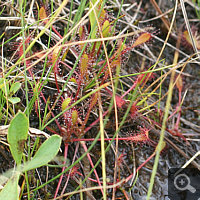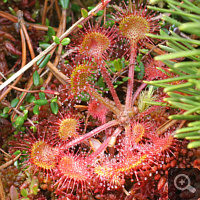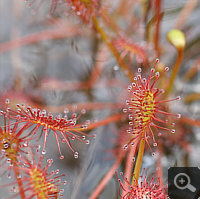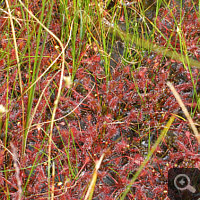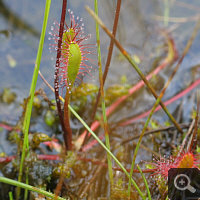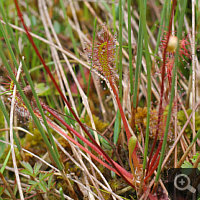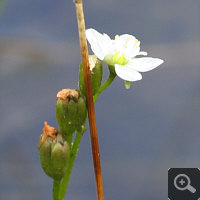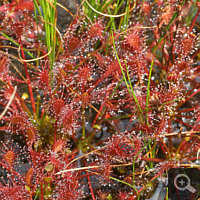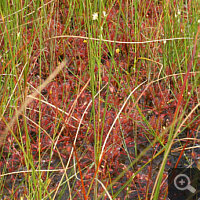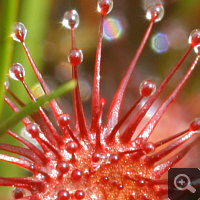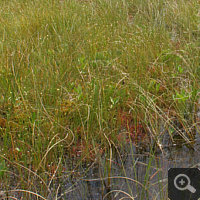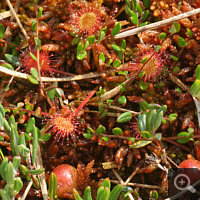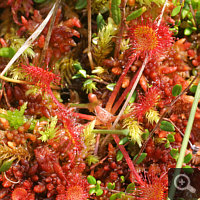Sundews (Drosera) in their natural German habitat
Introduction
The genus Drosera, a member of the Sundew family, is with circa 160 species in total the third largest carnivorous genus.
The genus is widespread worldwide. Main areas of distribution are escpecially Australia, but also South Africa.
With one exception are moist, acid to very acid habitats populated. Droserae are found in temperate zones with a frosty winter as well as in the tropics. Most species are rosette-forming, often lying flat on earth. In addition exist also climbing or perpendicular growing species. Diameter reaches from 1 – 2 cm up to 100 cm in the case of Drosera regia.
The sundew counts among active flypaper traps. Pediculated glands (tentacles) produce sticky drops, which base on a polysaccharide-solution. Mainly by the glitter of the dewdrops in the sun small insects are decoyed and taped. Whereas an olfactory (by the scent) enticement does not exist. Tentacles, sometimes even the whole leaf, are often distinctly movable. However, movement propensity varies clearly. Almost no movement shows for example Drosera filiformis, whereas other species as Drosera burmannii can turn around their tentacles by 180° within 1 – 2 minutes. A whole series of species, as for instance Drosera capensis, envelop finally the prey sandwich-like with their leaf. Numerous enzymes digest the ingredients and introduce them thereby to an utilisation by the plant.
In German raised bogs are three species to be found, namely Drosera anglica, Drosera intermedia and Drosera rotundifolia.
Great Sundew (Drosera anglica)
The Great Sundew is also called English Sundew. It is one of only three hardy, perennial species, which are native in Central Europe. Of these is Drosera anglica the rarest species and in Germany endangered.
It is native in the whole northern hemisphere, here it is to found especially in North Germany, but also in Southern Bavaria.
Like its relatives, you can find Drosera anglica in full-sunny locations in raised and transition bogs. The species grows usually between peatmosses on waterlogged soils, albeit mostly at drier sites as Drosera intermedia. Compared with its two German relatives is this species markedly more lime-tolerant, conceivably because of a influence of Drosera linearis.
It is expected, that Drosera anglica is of a hybridogenous origin, namely has evolved from a natural hybrid between Drosera rotundifolia and Drosera linearis. For this are indicative of new genetic researches and the fact, that Drosera anglica has a chromosome number of 2n=40, whereas the remaining North American species have a chromosome number of 2n=20.
Leaves are between 35 and 95 millimetres long. Thereby is apportioned to the elongated-spatulate leaf blade only 15 to 35 millimetres.
Also in the case of an intensive solar radiation Drosera anglica does not colour such dark red as Drosera intermedia and Drosera rotundifolia. Just as those produces the species in midsummer small, white blossoms.
Oblong-leaved Sundew (Drosera intermedia)
The Oblong-leaved Sundew is also a perennial, hardy raised bog plant. This species resembles the Great Sundew, but is smaller. Above all, the species let differ from each other on the basis of leaf blade.
Drosera anglica has a elongated-spatulate leaf blade.
Therefore this is distinct longer than broad. By contrast shows Drosera intermedia a distinct shorter leaf blade, which is spatulate to obovate. Leaf blade is only slightly longer than broad. Under intensive solar radiation the species can colour intensively red. In midsummer small, white blossoms are produced.
The species is native on the one hand in Europe, but in addition also in the east of North- and South America.
Interestingly are the plants from South America, which are primarily to be found on the Table Mountains, not hardy and differ slightly from their European relatives, so that these were described as Drosera intermedia ‚Roraimae’.
This species prefers in Germany very wet habitats. Quite often you can find for the most part flooded specimens.
All in all is the species more frequent than Drosera anglica.
Round-leaved Sundew (Drosera rotundifolia)
Der Rundblättrige Sonnentau ist ebenfalls eine mehrjährige, winterharte Art, die nahezu auf der gesamten Nordhalbkugel verbreitet ist. In Deutschland ist Drosera rotundifolia die häufigste Art, findet sich aber auch vor allem in Hochmooren, wo sie in aller Regel in Torfmoospolstern wächst.
The Round-leaved Sundew is also a perennial, hardy species, which is distributed almost in the whole northern hemisphere. In Germany is Drosera rotundifolia the most common species, is also to be found primarily in raised bogs, where it grows mostly in peat moss pads.
Drosera rotundifolia survives winter as well as Drosera anglica and Drosera intermedia with the aid of a winter bud, the so-called hibernakelum.
With Drosera anglica can this species build the natural hybrid Drosera x obovata.
The species is very easily to classify and not to confuse. Leaves lie flat on the soil or are only slightly erected. Leaf blade is rounded to transversely oval – often broader than long. Under an intensive solar radiation can leaf blade turn lushly red. This species produce also small, white blossoms.
All photos on this site were taken in early August 2012 in a transition bog at a Prealps lake in the Allgäu. Interesting accompanying plants were the Lesser Bladderwort (Utricularia minor) and the Bog Orchid (Hammarbya paludosa), an extremely rare raised bog orchid.

